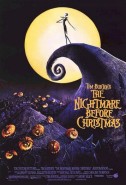Review by Jack Skellington . . . er, Seiley
Since its original release in 1993 as the first full-length stop-motion animated film, The Nightmare Before Christmas has become an enduring cult classic. Not only have animation fans and movie buffs proclaimed the brilliance of the film,
but the characters and visual look have entered into the realm of "trendy" pop culture. Indeed, this dark holiday tale is as popular today as it ever was. The inventive set-up of the story where two holidays collide, the wondrous variety of characters, and the highly-original art style continue to captivate people over ten years after its original release.
The fantastical setting is a world where each holiday has its own realm, and the film begins in Halloween Town as a sort of demented Dr. Seuss tale. Despite being lauded by everybody in the town, Jack Skellington - the resident Pumpkin King - yearns for something more, though he’s not sure what exactly that is. On Halloween night, while meandering through the woods, he comes across a portal to an entirely different land . . . Christmas Town. Dazzled by the sparkling lights, cheerful inhabitants, and an unusual new feeling within, Jack gleefully seeks to uncover the meaning of Christmas.
Despite the warnings from his secret admirer, the Frankenstein-esque Sally, Jack decides to lead the inhabitants of Halloween Town in taking over Christmas, and goes forward with his plan to take the role of Saint Nick for one night, whom he mistakenly identifies as “Sandy Claws.” Even with his good intentions, things start to go horribly wrong for Jack, and Christmas will be ruined unless he saves Santa from his kidnapper, the boisterous and over-the-top monster Oogie Boogie.

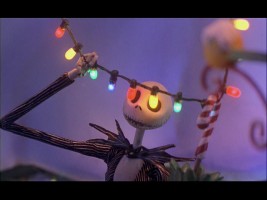
I only recently saw Nightmare for the first time. I liked the look of the movie a lot, and thought Danny Elfman’s music was well done, but other than that I was quite disappointed. A lot of it probably had to do with the hype surrounding it, perhaps putting my expectations in over-drive (the insane number of Jack Skellington shirts at Hot Topic irritated me too). I felt like I was missing something: what’s the hullabaloo about?
Yet, upon watching it a second time, I came to appreciate it much more. I picked up on something I didn’t really focus on during my first viewing – the movie is essentially about Jack trying to find meaning in his life. That’s what affects everything in the plot, and causes all the twists and turns.
It’s about him looking for something deeper, and looking the wrong place, while what he really wants is closer than he thinks. Therefore, even though it does have a bigger scope, the story as actually pretty personal,and I really admire that about it.
That may not be the main reason for the insane following the flick has, but that’s what makes it special for me. Of course, there’s a lot else for viewers to like. The interesting twists on arguably the two most popular celebrations make for good holiday movie viewing. Fans of Tim Burton will certainly like the visuals – he may not have directed, but his influence is complete.
In the end, I still feel Nightmare is pretty overrated. Yet that won’t stop me from recommending it as a very enjoyable and noteworthy movie.
Though originally released as a bare-bones DVD, Nightmare was eventually given much better treatment. It was re-issued in 2000 as a single-disc “Special Edition,” replicating many of the supplements from the movie's lauded laserdisc of yesteryear. The Special Edition, which quietly went out of print in 2006, is the subject of
this review.
 |
DVD Details
1.66:1 Non-anamorphic Widescreen
Dolby Digital 5.1 (English, French)
DTS 5.1 (English)
Subtitles: English, Spanish
Closed Captioned
Release Date: October 3, 2000
Single-sided, dual-layered disc (DVD-9)
Suggested Retail Price: $19.99 (was $29.99)
Black Keepcase |

VIDEO and AUDIO
The film is presented in its original aspect ratio of 1.66:1, in a non-anamorphic transfer. Though it is disappointing that the image is not enhanced for 16x9 televisions, the not-very-wide aspect ratio makes it easier to bear for those watching the film on a widescreen TV. The quality of the picture is superb, with spot-on display of colors and detail, and nary a print imperfection.
The sound can be heard through either Dolby Digital 5.1 or DTS 5.1 surround tracks. As far as I can tell, both tracks are very similar, and both are very high in quality. Audio consistently displays great range, while remaining natural and complementing the visuals perfectly.
Is there any difference between the original release and the SE release, when it comes to the movie’s presentation? Apparently, aside from the bonus DTS track on the Special Edition, both editions are equal when it comes to this department. The transfer and Dolby track seem exactly the same as the barebones release – in this case, that’s perfectly fine, since both are praiseworthy.
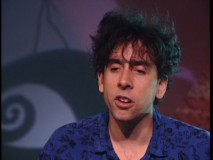
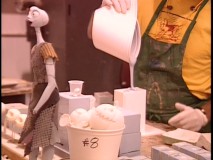

BONUS FEATURES
A feature-length audio commentary includes director Henry Selick and director of photography Pete Kozachik (if his name is any indication, he probably likes to “koza” up to “chiks”). The talking time is evenly split between the two,
both dwelling largely on the technicalities of the animation. While the information is interesting, I would find it hard to sit through over an hour of it, since the participants are extremely mellow and, frankly, hard to listen to.
“The Making of The Nightmare Before Christmas” (24:42), while not as long as other behind-the-scenes documentaries, is admirable due to its relatively non-promotional nature and detailed information on stop-motion animation. Key players Henry Selick, Tim Burton, and Danny Elfman are joined by other interviewees from the crew. After briefly setting up how the project got started and the important role the music played in the forming of the story, the majority of the run-time explains the tedious and laborious process of creating the characters and getting them to move and interact on miniature sets. Since it’s so packed with enlightening information, the featurette seems longer than it really is.
Next, a basic “Storyboard-to-Film Comparison” (3:45) displays rough storyboards alongside the finished film for a segment featuring a Halloween Town meeting. Unlike more recent extras like this, you cannot use the angle button to flip between the two, but it's easy to see the similarities and differences nonetheless.



Within a Deleted Scenes area, we get a nice selection of abandoned sequences, each shortly introduced by Selick, divided into two subsections. Deleted Storyboards holds three snippets excluded from the film before they went into production. “Behemoth Singing” (0:50) and “Oogie Boogie’s Song” (0:35) are extensions of musical numbers, while “Alternate Identity of Oogie Boogie” (1:20) is a surprising scene intended for the climax. Deleted Animated Sequences keeps “Jack’s Scientific Experiments” (2:00), “Vampire Hockey Players” (0:17), and “Oogie Boogie Shadow Dance” (0:25)”, which consist of lengthened scenes from the final cut. The only fully deleted scene is “Lock, Shock and Barrel” (2:15), depicting a completely excluded sequence where the three troublemakers spy on Oogie Boogie.
The Worlds of The Nightmare Before Christmas holds over 500 stills, indexed under “Halloween Town,” “Christmas Town,” and “The Real World” (no, not the MTV show). Character designs are given for Jack Skellington, Sally, Oogie Boogie, Lock, Shock and Barrel, Zero, The Mayor of Halloween Town, Santa Claus, Santa’s Helpers, and miscellaneous characters – with animation tests additionally provided for Jack, Sally, and Zero. Concept art is also displayed for the various environments in each respective world.
Posters and Trailers has another still gallery, showing 5 poster designs from the original theatrical release. We then get a “Teaser Trailer” (1:40), which emphasizes the breakthrough nature of the movie by highlighting Disney’s past accomplishments in animation and showing some behind-the-scenes footage. Notably, it features the
Walt Disney Pictures logo, since it was made before the company decided to release it under their Touchstone banner. Afterwards, there’s the final “Theatrical Trailer” (1:23), which focuses more on the story of the movie and more indicative of its mood than the teaser. Though not in this section, a James and the Giant Peach Trailer (1:25) is
also found on the main menu.



The final section, Tim Burton’s Early Films, is probably the highlight of the bonuses. Two of Burton’s first directorial efforts, filmed in black and white, make
their appearance here, available exclusively on this DVD. Both showcase aspects that would eventually find themselves in Nightmare later in his career.
“Vincent” (5:50), made in 1982, features the same animation technique as Nightmare, and is very similar in style. Seeking to pay tribute to his favorite actor, Burton gives us a tale about a boy named Vincent who wishes to be Vincent Price . . . narrated through rhyming lyrics by Vincent Price himself!
 |
The young lad is shown to be a rather schizophrenic fellow, constantly going from his normal personality to a maniacal Vincent Price persona. It’s a very Burton-esque short, adequately described by Henry Selick as “part Dr. Seuss and part German expressionism.”
“Frankenweenie” (29:50), my favorite of the two, is a live-action film from 1984, featuring Barret Oliver, Shelly Duvall, and Daniel Stern (better known as one half of the Wet Bandits). It’s a satire on the classic story of “Frankenstein,” depicting a kid of the same name trying to bring his dead dog Sparky back to life after he gets hit by a car. Once he succeeds, he finds it hard to keep Sparky a secret, and it's not long before some angry neighbors chase the dog into a burning windmill, of the miniature golf variety! What other director can masterfully take dark subject matter and make it into something that feels amusing and zany enough to have it be from the perspective of
a ten-year-old? Burton definitely has a knack for this, and “Frankenweenie” shows off his talent tremendously.
Moody and atmospheric, the spooky menus adequately represent the movie itself. They feature subtle animation, such as flickering lights, and an eerie selection of music from the score. The disc is held in a standard black amaray keepcase. The front cover features a shiny gold overlay on the “Special Edition” banner design. Inside, there is a 4-page insert that contains a chapter listing, production notes, and a listing of the extras alongside some small pictures of the characters.
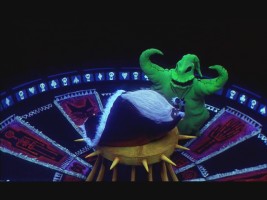
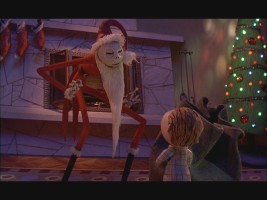
CLOSING THOUGHTS
While overblown in its popularity, The Nightmare Before Christmas is still a treat to watch, due to its unique story and animation. Though it may not amount to the quantity of two-disc sets, this “Special Edition” certainly matches or succeeds most other DVDs in quality.
More on the DVD / Buy from Amazon.com Marketplace

Buy the new and improved versions from Amazon.com:
2-Disc Collector's Edition DVD / Ultimate Collector's DVD Set / Blu-ray Disc
